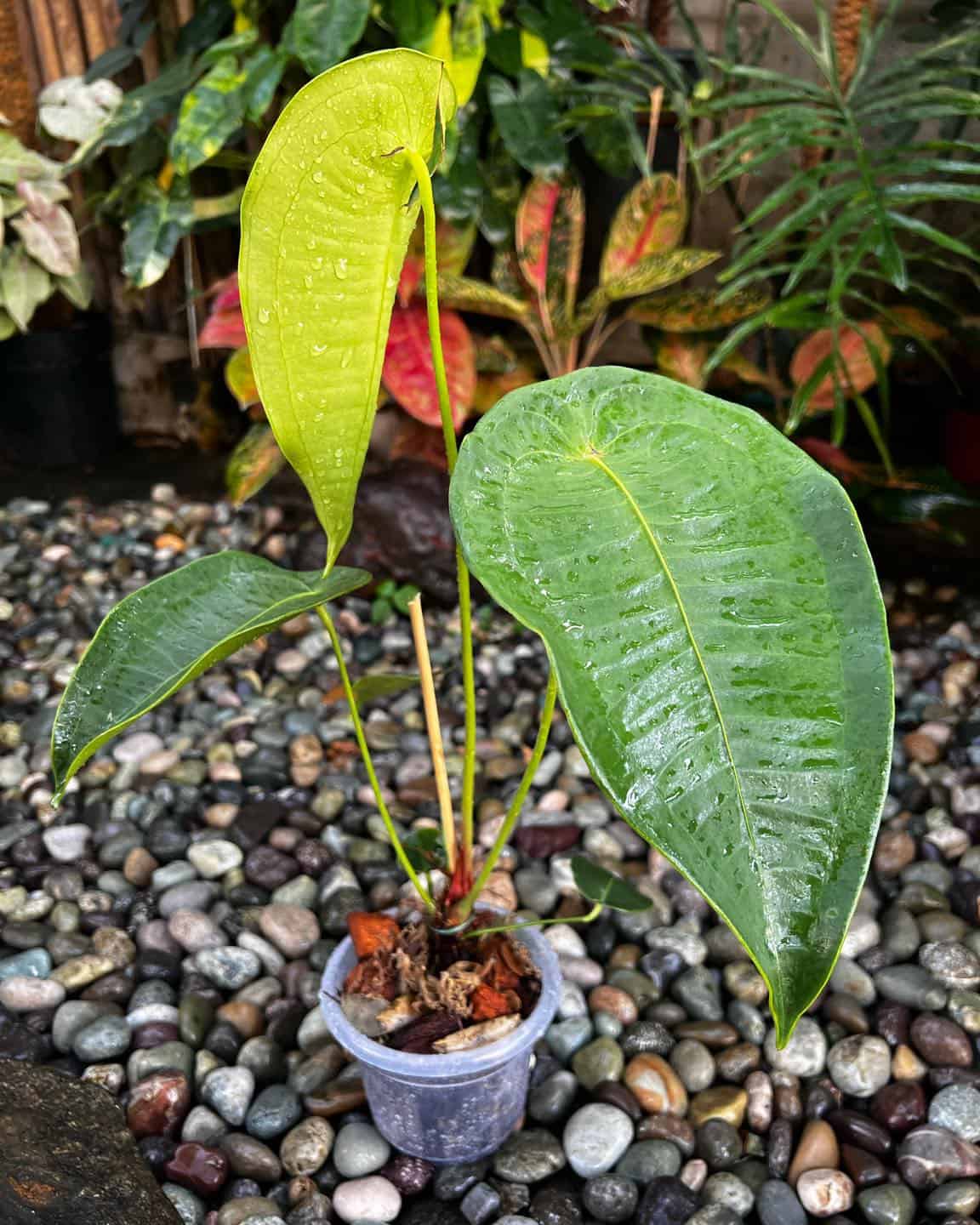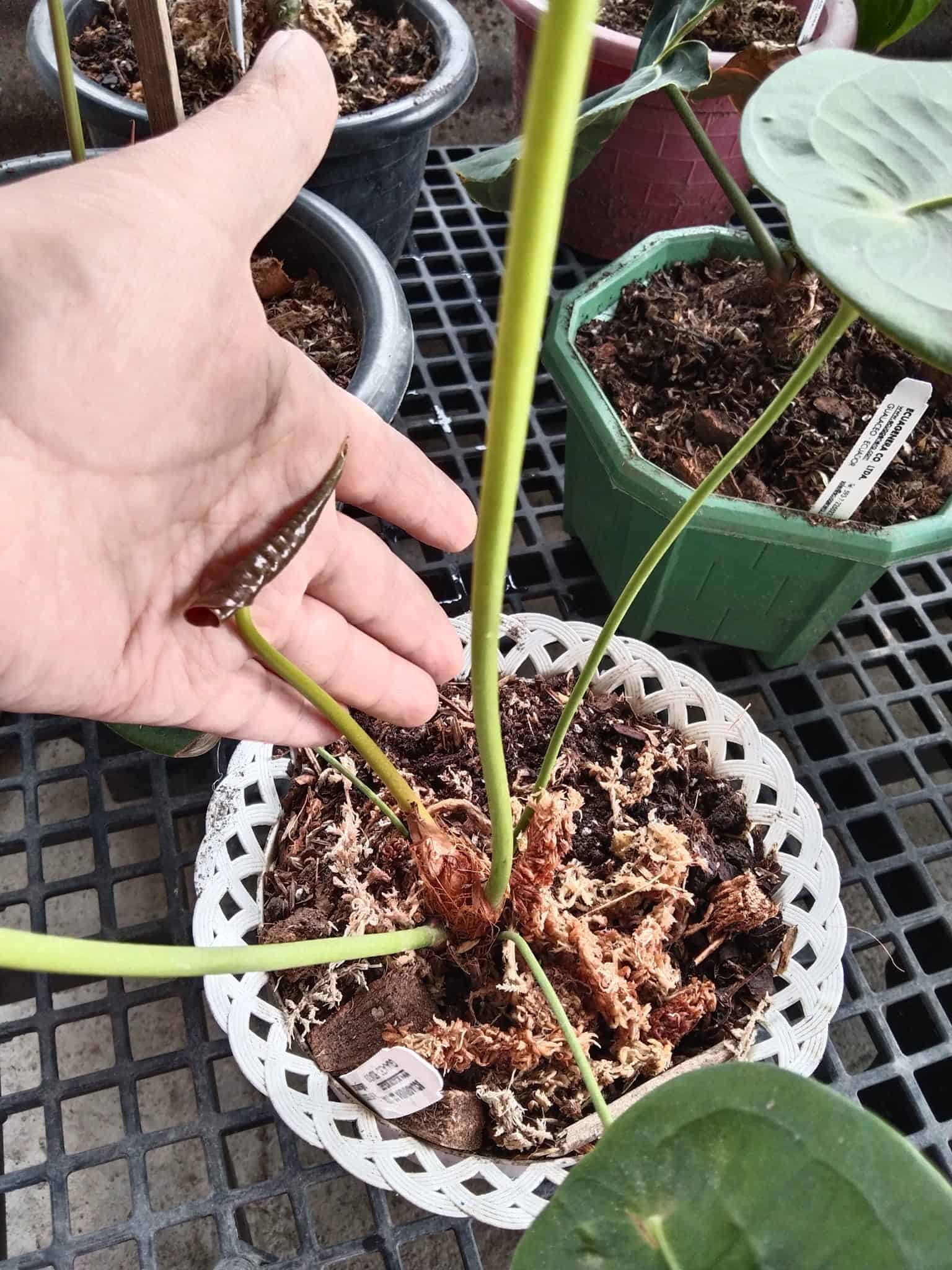Anthurium Peltigerum can lure anyone with its peltate leaves and parallel tertiary veins, making it look like a turtle shell.
Thus, read on to understand the detailed care dynamics of Anthurium Peltigerum with things you should refrain from.
Table of Contents Show
Overview of Anthurium Peltigerum
Anthurium Peltigerum is a tropical aroid native to the tropical regions of South America.
Due to the distinct foliage, Anthurium Peltigerum is one of the only three Anthurium varieties with “peltate” leaves.
If you want to know about the leaves and some more features of Anthurium Peltigerum, the following table will guide you through them.

| Features | Descriptions |
|---|---|
| Common Name | "Turtle Shell" Anthurium |
| Scientific Name | Anthurium peltigerum |
| Family | Araceae |
| Status and Ecology | Life Cycle: Evergreen Perennial Habit: Terrestrial or Epiphytic Herb Habitat: Tropical Rainforest Native Range: Northwestern Ecuador to Southwestern Columbia USDA Zones: 10b to 11 |
| Growth Rate | Slow to Modest |
| Plant Size (Height and Spread) | 100-101 centimeters × 75 centimeters |
| Growing Season | Early Spring to Late Summer (March to August) |
| Leaf | Shape: Ovate (Egg-Like) with tapering leaf tips Size: 6 inches to 20 inches long Color: Light to Dark Green Texture: Smooth |
| Flowering Season | Summer (June to August) |
| Flower | Inflorescence: Spathe and Spadix Color: Green or Red Spathe and Light Green to Green Spadix Shape: Leafy Spathe and Cylindrical Spadix |
| Grown for | Ornamental Leaves |
| Toxicity | Toxic to Pets and Humans |
| Specialty | One of the 3 Anthurium species with petiole attached completely with the marginal surface of the leaf |
Anthurium Peltigerum: Ultimate Care Guide
Aroids like Anthuriums admire the hot, humid, and low-light regions with plenty of organic matter in the soil.
This kind of environment is only present in tropical forests.

Take into the deeper analysis and growing guide for Anthurium Peltigerum.
1. Light and Temperature
To maintain the correct lighting and temperature, locate your Anthurium plant near an east-facing window in the morning and move it under shade during the day.
Less light can turn the Anthurium leaves yellow and droopy, and leaves may fall off the plant due to low temperatures. The plant may also elongate the stems and leaves in search of a light source.
Intense light can surge the temperature leading to curled, yellow, brown, and crispy leaves.
At night, sustain a surrounding temperature of around 60°F. If possible, cover the Anthurium plants with a frost blanket in fall and winter.
To learn more about the light demands of Anthuriums, you can get a little lead on Anthurium varieties.
2. Watering and Humidity
Like all tropical plants, Anthurium Peltigerum is sensitive to excess soil water and demands high humidity.
Soggy soil can lead to waterlogging conditions, and the roots can get smothered. So, they turn black and mushy, and the soil smells “fishy” due to the rotting roots.
Contrarily, less water cause underwatering symptoms like wilting leaves and fading leaf colors.
In later stages, the margins and tips of the leaves turn yellow, brown and brittle.
The plant stays dormant in fall and winter, so keep the top 1-2 inches of the potting soil dry between the watering bouts when the plant is resting.
Surging humidity can invite fungal growth in the soil, leaves and lower stems.
The plant cannot unfurl its leaves, experiences fewer blooms, and the leaves may drop when the humidity levels reduce below 50%.
To maintain the correct humidity, place the Anthuriums together with other houseplants in a well-lit bathroom or place the individual plant on a pebble tray.
For watering, you can place the plant on a water tray for 15-20 minutes to try the approach of bottom watering.
3. Soil and Fertilizer
Aroids like Anthurium Peltigerum prefer soil that has percolating and water-retaining elements, the right amount of acidity, and enough nutrients.
Cloggy soil can hold the water and form a puddle where the plant can experience a condition called “wet feet.”
In wet feet, the roots completely drown and cannot get oxygen, leading to root rot.
Highly porous soil can leach fertilizer or other mineral salts, causing nutrient deficiencies.
Avoid fertilizing the plant in fall and winter to prevent fertilizer burn.

If the soil accumulates white, crusty fertilizer salts, flush them out by keeping the plant under weak running tap water 4-5 times.
Get the premium brands below in case you find it hard to get proper soil and fertilizer for your Anthurium.
4. Potting and Repotting
Anthuriums are slow to medium growers and take 1-2 years to become root-bound.
But you must use 2-4 inches wider and deeper planters with drainage holes to repot the plant every time.
To repot, water your Anthurium 1-2 days earlier and place it in a cool, dry place.
While repotting, remove the plant from its old container by releasing its roots from the soil clumps.
Remove the dead or damaged roots and place the plant inside the new planter. Keep filling the potting mix from the sides up to 1/2 inch below the brim of the pot.
When the roots are completely covered, gently give it a press, place the plant near an east-facing window, and water the soil to keep it moist.
5. Occasional Pruning
Pruning can be done year-round for Anthuriums to remove dead or injured parts.
Moreover, punctual trimming offers a bushy form and reduces the incidence of pests or diseases for the plant.
To prune the plant, simply snip the damaged leaves at their base and remove any fallen or decaying leaves for proper disposal.

If the plant is suffering already, separate it from other houseplants to prevent the extent of bugs or diseases.
Use weak water sprays to cast away visible pests or manually remove them using q-tips dipped in disinfectants.
Additionally, apply broad-spectrum fungicides at the site of disease infections to kill and deter the pathogens and their spores.
Growth Characteristics of Anthurium Peltigerum
Anthurium Peltigerum grows actively throughout the spring and summer. With proper care, the plant can attain a mature height of around 1 meter and spread of about 0.75 meters.
But the plant relaxes from fall to winter and goes on a long winter sleep, where it rarely shows any visible growth.
As spring arrives and the ground becomes warm, the plant grows again by getting new leaves.
The egg-like shape and the venation make the leaves resemble a turtle shell.
Leaves are supported by thin, light green petioles flaring from the plant’s stem.
The leaves hide most underground parts of the plant, but a flowering branch emerges during summer from the stem.
Besides, the flowering stalk becomes more prominent after crowning a spathe and a spadix at the top.

The spathe is a green or red leafy structure shrouding a light green spadix.
Spathe helps the plant attract pollinators, and spadix bears minuscule flowers that develop into berries in the late summer or at the onset of winter.
Toxicity of Anthurium Peltigerum
Anthurium Peltigerum is a toxic plant containing calcium oxalate in most of its parts.
The calcium oxalate is present in the sap and is in the form of sharp, microscopic crystals that causes irritation and skin rashes in humans on contact.
Pets may lick or bite the plant parts, leading to progressive symptoms like oral and nasal irritation, swelling of tongue and gastric tracts, vomiting, hoarse barks or meows, and gasping.
Although milk is a homemade remedy to wash the calcium oxalate from your pet’s mouth, the symptoms may take time to disappear.
So, it’s ideal to request an emergency by calling the helpline numbers right away before your pet’s health worsens.
- Animal Poison Control Center (APCC): (888) 426-4435
- National Capital Poison Center (NCPC): (800) 222-1222
Propagation Methods for Anthurium Peltigerum
Stem cuttings are a successful way to propagate Anthurium Peltigerum in early spring after the new growth.
Although Anthurium produces seeds, there is less chance that the plant will beget flowers in a home environment in the first place.
You can directly place the cuttings in the soil or transplant them in the soil after they grow new roots in water.
- Select a healthy 4-6 inches long stem cutting with a small piece of root and 2-3 leaf nodes.
- Leave the cutting wrapped in a paper towel overnight after washing and drying so that the cut portion becomes tough.
- Place the cutting in a glass jar with hormonal water and locate the setup near an east-facing window.
- Cover the cutting with a plastic bag to seal humidity and temperature.
- Keep a humidifier set at 50% to 80% near the transplant.
- In 4-8 weeks, the cuttings sprout new white roots.
- Fill a pot with fresh potting soil and then transplant the cutting about 2-3 inches deep in the soil.
- If you are using multiple stem sections, keep one cutting per pot.
- Once the cutting establishes itself firmly, check for new growth weekly.
- When the cuttings grow new leaves, continue with normal care.
Anthurium Peltigerum for Sale
Propagating and growing Anthuriums from seeds or cuttings may be a bit hassling. But you can rely on the following sites to welcome a live plant directly to your doorstep.
| Commercial Sites | Expected Delivery Period |
|---|---|
| Etsy | Within 10 to 26 days after placing an order |
| eBay | Within 1 to 2 weeks after placing an order |
| The Leafy Soul Mates | Within 1 to 2 weeks after placing an order |
FAQs Related to Anthurium Peltigerum
Can Anthurium Peltigerum Grow Without Soil?
Anthurium Peltigerum can grow without soil through a process called “hydroponics.”
To do this, take a healthy stem cutting from an Anthurium plant and dip it in a jar containing distillate water. After 4-8 weeks of care, you shall see small roots growing from the cut portion.
Are Anthurium Peltigerum “Chocolate” and Anthurium Peltigerum “Narrow” Same?
Anthurium Peltigerum “Chocolate” and Anthurium Peltigerum “Narrow” are two varieties of Anthurium Peltigerum.
The margin of the leaves towards the middle is bulged in “Chocolate,” while the margin of the leaves is straightly wavy towards the middle in “Narrow.”
Does Anthurium Peltigerum Produce Seeds?
Anthurium Peltigerum is a flowering plant that produces seeds, and in the wild, berries can be seen sticking to the dry spadix after 5-6 months of flowering.
But, flowering is not guaranteed in a home-care environment.
From Editorial Team
Pay Attention to Locating Anthurium Peltigerum
Avoid only north-facing windows while locating the plant, or place it next to a balcony door.
You can grow Anthurium Peltigerum with companion houseplants, including African Violet, Aglaonema Plant, and Bonsai Tree.


